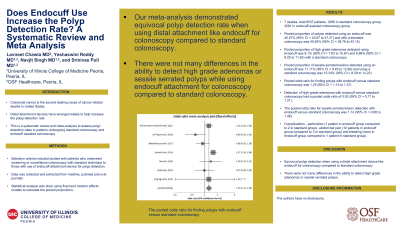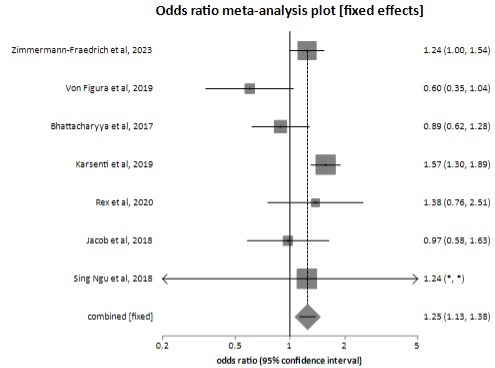Monday Poster Session
Category: General Endoscopy
P1976 - Does Endocuff Use Increase the Polyp Detection Rate? A Systematic Review and Meta Analysis
Monday, October 23, 2023
10:30 AM - 4:15 PM PT
Location: Exhibit Hall

Has Audio
- LC
Lavneet Chawla, MD
OSF Saint Francis Medical Center
Peoria, IL
Presenting Author(s)
Yeshaswini Reddy, MD1, Lavneet Chawla, MD2, Navjit Singh, MD1, Srinivas Puli, MD1
1University of Illinois College of Medicine at Peoria, Peoria, IL; 2OSF Saint Francis Medical Center, Peoria, IL
Introduction: Colorectal cancer is the second leading cause of cancer related deaths in the United States, and screening colonoscopy plays an important role in reducing cancer related deaths. The use of distal attachment devices has emerged widely to help increase polyp detection. This is a systematic review and meta-analysis to assess polyp detection rates in patients undergoing standard colonoscopy and endocuff assisted colonoscopy.
Methods: Selection criteria included studies with patients who underwent screening or surveillance colonoscopy with standard technique to those with use of endocuff attachment device for polyp detection. Data was collected and extracted from medline, pubmed, and Ovid journals. Statistical analysis was done using fixed and random effects models to calculate the pooled proportions.
Results: We included 7 studies with a total of 6537 patients included, of which 3256 were in standard colonoscopy group and 3281 in endocuff assisted colonoscopy group. The pooled proportion of polyps detected using an endocuff was 45.57% (95% CI = 43.87 to 47.27) and with a standard colonoscopy was 40.46% (95% CI = 38.78 to 42.15). Detection of high-grade adenomas using an endocuff had a pooled proportion of 9.1% (95% CI = 7.63 to 10.67) when compared to 9.88% (95% CI = 8.25 to 11.63) with a standard colonoscopy. The pooled proportion of sessile serrated lesions detected using an endocuff was 11.11% (95% CI = 9.45 to 12.89) and using a standard colonoscopy was 10.34% (95% CI = 8.59 to 12.22). The pooled odds ratio for finding polyps with endocuff versus standard colonoscopy was 1.25 (95% CI = 1.13 to 1.37), these findings are shown in Figure 1. The detection of high-grade adenomas with endocuff versus standard colonoscopy had a pooled odds ratio of 0.93 (95% CI = 0.71 to 1.21). The pooled odds ratio for sessile serrated lesion detection with endocuff versus standard colonoscopy was 1.14 (95% CI = 0.88 to 1.48). Complications evaluated included perforation (1 patient in endocuff group compared to 2 in standard group), abdominal pain (10 patients in endocuff group compared to 3 in standard group) and bleeding (none in endocuff group compared to 1 patient in standard group).
Discussion: Our meta-analysis demonstrated equivocal polyp detection when using a distal attachment device like endocuff for colonoscopy compared to standard colonoscopy. There were not many differences in the ability to detect high grade adenomas or sessile serrated polyps.

Disclosures:
Yeshaswini Reddy, MD1, Lavneet Chawla, MD2, Navjit Singh, MD1, Srinivas Puli, MD1. P1976 - Does Endocuff Use Increase the Polyp Detection Rate? A Systematic Review and Meta Analysis, ACG 2023 Annual Scientific Meeting Abstracts. Vancouver, BC, Canada: American College of Gastroenterology.
1University of Illinois College of Medicine at Peoria, Peoria, IL; 2OSF Saint Francis Medical Center, Peoria, IL
Introduction: Colorectal cancer is the second leading cause of cancer related deaths in the United States, and screening colonoscopy plays an important role in reducing cancer related deaths. The use of distal attachment devices has emerged widely to help increase polyp detection. This is a systematic review and meta-analysis to assess polyp detection rates in patients undergoing standard colonoscopy and endocuff assisted colonoscopy.
Methods: Selection criteria included studies with patients who underwent screening or surveillance colonoscopy with standard technique to those with use of endocuff attachment device for polyp detection. Data was collected and extracted from medline, pubmed, and Ovid journals. Statistical analysis was done using fixed and random effects models to calculate the pooled proportions.
Results: We included 7 studies with a total of 6537 patients included, of which 3256 were in standard colonoscopy group and 3281 in endocuff assisted colonoscopy group. The pooled proportion of polyps detected using an endocuff was 45.57% (95% CI = 43.87 to 47.27) and with a standard colonoscopy was 40.46% (95% CI = 38.78 to 42.15). Detection of high-grade adenomas using an endocuff had a pooled proportion of 9.1% (95% CI = 7.63 to 10.67) when compared to 9.88% (95% CI = 8.25 to 11.63) with a standard colonoscopy. The pooled proportion of sessile serrated lesions detected using an endocuff was 11.11% (95% CI = 9.45 to 12.89) and using a standard colonoscopy was 10.34% (95% CI = 8.59 to 12.22). The pooled odds ratio for finding polyps with endocuff versus standard colonoscopy was 1.25 (95% CI = 1.13 to 1.37), these findings are shown in Figure 1. The detection of high-grade adenomas with endocuff versus standard colonoscopy had a pooled odds ratio of 0.93 (95% CI = 0.71 to 1.21). The pooled odds ratio for sessile serrated lesion detection with endocuff versus standard colonoscopy was 1.14 (95% CI = 0.88 to 1.48). Complications evaluated included perforation (1 patient in endocuff group compared to 2 in standard group), abdominal pain (10 patients in endocuff group compared to 3 in standard group) and bleeding (none in endocuff group compared to 1 patient in standard group).
Discussion: Our meta-analysis demonstrated equivocal polyp detection when using a distal attachment device like endocuff for colonoscopy compared to standard colonoscopy. There were not many differences in the ability to detect high grade adenomas or sessile serrated polyps.

Figure: Odds Ratio Meta-analysis Plot
Disclosures:
Yeshaswini Reddy indicated no relevant financial relationships.
Lavneet Chawla indicated no relevant financial relationships.
Navjit Singh indicated no relevant financial relationships.
Srinivas Puli indicated no relevant financial relationships.
Yeshaswini Reddy, MD1, Lavneet Chawla, MD2, Navjit Singh, MD1, Srinivas Puli, MD1. P1976 - Does Endocuff Use Increase the Polyp Detection Rate? A Systematic Review and Meta Analysis, ACG 2023 Annual Scientific Meeting Abstracts. Vancouver, BC, Canada: American College of Gastroenterology.
